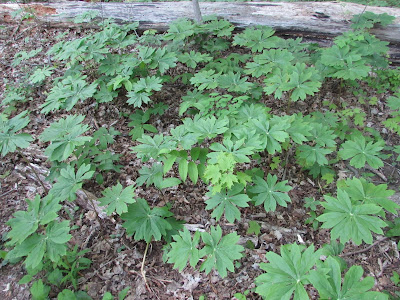Nature Note #169: Can't See the Maples for the Mayapples
 |
| Mayapples (Podophyllum peltatum) |
Plants have the uber important role in most ecosystems as the chief providers of shelter, food, and most importantly, oxygen. According to North Carolina State University's Tree Facts page, a single tree can take in up to 48 pounds of carbon dioxide per year, cementing their value as invaluable converters of this greenhouse gas into an important breathable one. However, the plants I was admiring were not the trees, but a ground level plant grows in what looks like a shrunken and out of place colony of palm trees.
The May-apple is a common woodland plant that starts to appear in the Northeast in early May and continues to grow well into the summer months. They are also known as Indian apple, raccoonberry, and American mandrake. It was their unusual appearance that first attracted my attention when I worked in New Jersey a few years back. Their palm tree like appearance had me imagining that gnomes and fairy folk would use it as a parasol or umbrella to protect them temporarily from the elements.
In spite of its whimsical appearance, every part of this plant is poisonous with their ripened fruit being the exception. They, like all poisonous organisms, have the potential to save many lives if their toxins can be harnessed to aid mankind. For example, the genus they belong to is called Podophyllum with the extract that is produced from their rhizomes and roots being called podophyllotoxin. It is the main ingredient used to treat certain medical conditions caused by the human papillomavirus, as well as being applied as a chemotherapy to treat lung cancer and lymphomas.
Another important use is as food for local wildlife. May-apple have declined somewhat as one of their major seed distributors have also declined due to habitat fragmentation, road fatalities, and capture for the pet trade. The creature I'm referring to is the Eastern box turtle and is state endangered in New York and listed as Vulnerable by the IUCN throughout its range from southern New England to Texas, Florida, and parts of Mexico. It is thought that this species not only feeds on the fruits of the May-apple, but is also instrumental in distributing seeds that they have excreted after having enjoyed a meal of May-apple.
When fully ripe, it resembles a wrinkled lemon with large seeds inside its soft core. The fruit is referenced all over the internet as a source of food that can be eaten (only when fully ripe) and even be turned into a jelly. One note of caution when foraging for wild edibles is that even if you're fairly certain that what you're looking at is edible; if you have any doubts about it, it is best left alone. You needn't end up like Christopher McCandless being poisoned by a plant that looked or resembled one that was edible, but is barely even palatable.
As a friend of mine once put it, "everything is edible, once."
I won't be risking a purge due to the offerings from a potent woodland wildflower any time soon, but instead, enjoy another unique denizen of the northeast woodland. Hopefully, scientists and others in biomedicine can continue to discover new uses for these often overlooked, but important herbaceous plants.
Sources:
In spite of its whimsical appearance, every part of this plant is poisonous with their ripened fruit being the exception. They, like all poisonous organisms, have the potential to save many lives if their toxins can be harnessed to aid mankind. For example, the genus they belong to is called Podophyllum with the extract that is produced from their rhizomes and roots being called podophyllotoxin. It is the main ingredient used to treat certain medical conditions caused by the human papillomavirus, as well as being applied as a chemotherapy to treat lung cancer and lymphomas.
Another important use is as food for local wildlife. May-apple have declined somewhat as one of their major seed distributors have also declined due to habitat fragmentation, road fatalities, and capture for the pet trade. The creature I'm referring to is the Eastern box turtle and is state endangered in New York and listed as Vulnerable by the IUCN throughout its range from southern New England to Texas, Florida, and parts of Mexico. It is thought that this species not only feeds on the fruits of the May-apple, but is also instrumental in distributing seeds that they have excreted after having enjoyed a meal of May-apple.
 |
| Male Eastern box turtle (Terrapene carolina carolina) |
As a friend of mine once put it, "everything is edible, once."
I won't be risking a purge due to the offerings from a potent woodland wildflower any time soon, but instead, enjoy another unique denizen of the northeast woodland. Hopefully, scientists and others in biomedicine can continue to discover new uses for these often overlooked, but important herbaceous plants.
Sources:
- Information on the May-apple was found at these websites.
- https://en.wikipedia.org/wiki/Podophyllum
- http://www.newyorker.com/books/page-turner/how-chris-mccandless-died
- https://en.wikipedia.org/wiki/Podophyllotoxin
- https://altnature.com/gallery/mandrake.htm
- http://www.wildflower.org/plants/result.php?id_plant=POPE
- The photo is a public domain photo from Wikipedia and can be found here.


Comments
Post a Comment